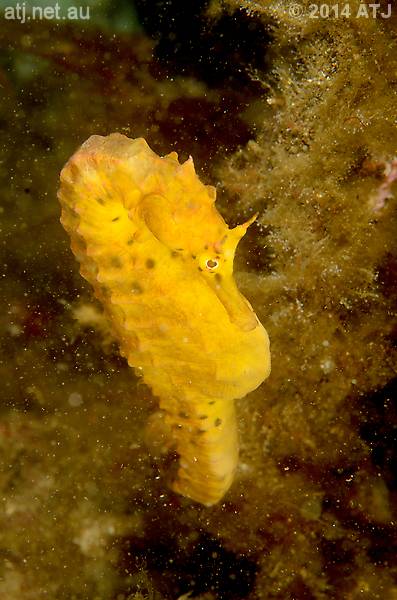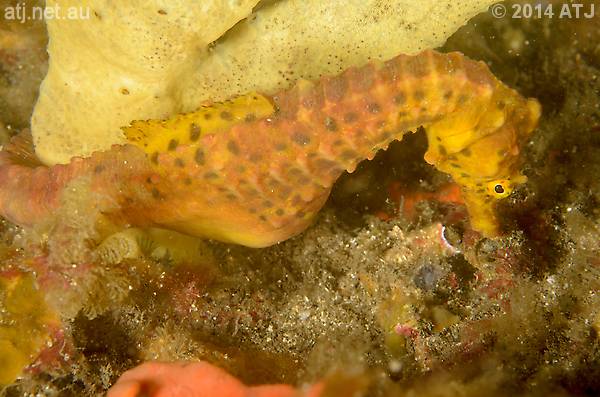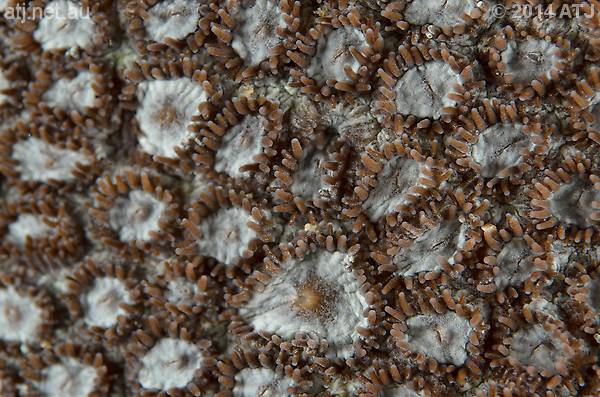Dive Details
Location
Date
12 July 2014
Time
2:35pm - 3:51pm
Details
There was quite a bit of wind chop across the bay but at the shore near The Leap is was pretty calm with just a small swell washing over the low platform. The water looked quite clear, too.
I jumped in off the low platform and straight out from The Leap the visibility was around 10 metres. I descended and swam at 60%deg; to the sand line. The visibility was good until I hit around 12 metres when it started to deteriorate. By the time I hit the sand line at 21 metres, the visibility was only 3-5 metres. There was a bit of surge which was picking up debris, including the snot algae and it was staying in the water column. This made photography less than ideal. The only good thing is that perhaps it will remove all the snot algae off the rocks and next time I dive here the rocks will be cleaner.
I swam to the rock where "Lucy" and "Bob", the pot-bellied seahorses, were last seen but I could not find either of them. I looked around the adjacent rocks but could not find them. The poor visibility was not helping. Hopefully, we'll get better visibility next time and have a better chance at locating them.
I continued on to Seahorse Rock and found "Rosie" on the rock behind, where she usually is. I then went on to the flat top boulder where "Max", the orange painted angler, as been. As I approached a rock a medium sized wobbegong swam passed. I went around behind the boulder to look for "Max" and as I did, the wobbegong swam under me, twice. It was like it was doing laps of the boulder. It was a little disconcerting as I had to watch my fins and it made it difficult to concentrate on finding "Max". Whether that was the reason or not, I never did find "Max".
Next I stopped at the rock with "Southern Cross", "Richie" and "Pierre". I found "Southern Cross" immediately, and then "Richie" in a spot I have seen him many times before. It took me a while to find "Pierre" but he was in a spot I have seen him previously.
After the seahorses I checked the location we'd seen the red indianfish last time but I could not see it. As I swam on I came across two weedy seadragons but didn't even attempt to photograph them because of the poor visibility and stuff in the water.
I continued along the sand line quite quickly to the basket star as I wanted to have plenty of air left to look for "Big John", the orange form undescribed angler. I looked for the pygmy pipehorse I have seen regularly since April but it appears to have moved on.
For the rest of the dive I made a concerted effort to find "Big John". I managed to locate the exact rock it had been on last weekend but it was no longer there. I then circled the area checking out the rocks. A lot of the rocks have kelp on them and if it was under the kelp I'd never see it. I did find two Port Jackson sharks. I suspect we'll see more of them over the next few months.
I gave up the search and went to 5 metres for my safety stop. At the safety stop the visibility improved to 10 metres or so. I exited at The Steps.
Seas
Slight
Visibility
3-10 metres
Duration
75 minutes
Maximum depth
21.1 m
Average depth
12.8 m
Water temperature
15.4°C
Dive Profile from Citizen Hyper Aqualand

Tides at Botany Bay AEST
Note that tides at dive site may vary from above location.
Low
2:00am
0.23m
High
7:54am
1.47m
Low
1:35pm
0.36m
High
8:09pm
2.05m
Camera gear
Camera
Nikon D7000
Lens
Nikon AF Micro-Nikkor 60mm f/2.8D
Housing
Ikelite 6801.70
Lens port
Ikelite Flat Port 5502.41
Strobe
2 x Ikelite SubStrobe DS161
Photographs
Depth information, where present, indicates the depth of the camera when the photograph was taken and can be used to approximate the depth of the subject.

Reaper cuttlefish, Sepia mestus. 19.8 m.

Female pot-bellied seahorse, Hippocampus abdominalis, ("Rosie"). 19.4 m.

Female pot-bellied seahorse, Hippocampus abdominalis, ("Southern Cross"). 17.6 m.

Male pot-bellied seahorse, Hippocampus abdominalis, ("Richie"). 17.3 m.

Male pot-bellied seahorse, Hippocampus abdominalis, ("Pierre"). 17.5 m.

Basket star, Astrosierra amblyconus. 12.9 m.

Stony coral, Plesiastrea versipora. 5.9 m.

Stony coral, Plesiastrea versipora. 5.8 m.